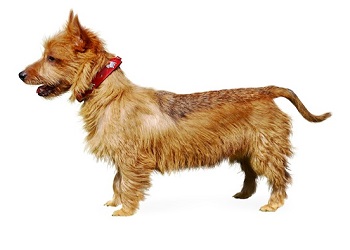 The Australian Terrier is a truly Australian dog. It was first bred in the midlands of Tasmania in the early 1800s from descendants of British terriers which included, at times, the old ‘Scotch’ terrier, the Dandie Dinmont, the Cairn and the Yorkshire Terrier.
The Australian Terrier is a truly Australian dog. It was first bred in the midlands of Tasmania in the early 1800s from descendants of British terriers which included, at times, the old ‘Scotch’ terrier, the Dandie Dinmont, the Cairn and the Yorkshire Terrier.
The breed was recognized officially around 1880 as the ‘Rough-Coated Terrier’ then in 1899 as the Australian Terrier. It has similarities to the Silky Terrier, although the Silky is generally smaller and has a longer and soft coat.
Originally bred as working dogs with the specific job of eradicating rats and mice, Australian Terriers love the thrill of a good chase and rummaging around the garden. They are highly intelligent dogs with good train-ability.
A big dog’s bravado in a small dog’s body’s the best way to describe these feisty, fun-loving dogs.
Personality
Australian Terriers are courageous, assertive and versatile. They are small, sturdy dogs with a great appetite for play and this makes them an ideal family pet. They love to be both indoors and outdoors, although they can be aggressive with other dogs, so beware if you introduce new pets into the household.
These dogs are very loyal and they make reasonable guard dogs because they are highly alert and have a keen instinct for knowing if there’s something unusual in their surroundings. However, because of their small stature they are not particularly intimidating, though they can appear so to strangers.
They love all the members of their family, but tend to form a strong attachment to one member (usually the person who feeds them). They can also be mischievous and stubborn. Obedience training is recommended early in the pup’s life to manage these traits.
Australian Terriers love their family – prefer humans to other dogs – and like to be inside with their human family. If kept outside all the time they get lonely and can develop into barkers and be destructive.
Upkeep
Australian Terriers have a long coat which needs brushing daily. They also shed and although shedding is minimal, it might not suit people with allergies.
They need bathing every few months or when dirty. Like most dogs, their coat sheds every six months and need stripping. This can be done by hand by gently pulling the loose coat out or with a stripping comb.
These are fairly energetic dogs and require a walk every day, although they can be just as satisfied with a decent game of fetch or Frisbee.
Like all dogs, Australian Terriers require regular tick, flea, intestinal worms and heartworm treatments. Consult your veterinarian on treatment options. Desexing and vaccination against diseases, such as the deadly parvo virus and highly infectious canine cough, are also important to discuss with your vet.
Compatibility
These dogs are perfect pets for families. They thrive on activity and play, and they have the energy levels to match young children. Like with all dogs, supervision of your Australian Terrier is important around children, in particular young children who do not understand how to handle small animals. These dogs are very friendly, but like any canine, they can fight back with a good bite if aggravated.
These dogs are robust little dogs so they can be picked up and carried around, and will fit easily into the family car for any type of outing. Their rough coat gives them an adorable, cuddly appearance and they can be very warm and affectionate animals.
Because of their size they can be accommodated in apartments, but their genetics also mean they like the stimulation of hunting, chasing and foraging so a garden (even a small one) that the dog can claim complete ‘ownership’ of is ideal.
Fact file
Breed classification Terrier
Size Small
Origin Australia, with British descendants
Lifespan 12-15 years
Colours Blue and Tan, Sandy or Red
Cost $500 – $850
Common hereditary problem Legg-Perthes (a disease of the hip joints), eye defects, diabetes, epilepsy (rare).
